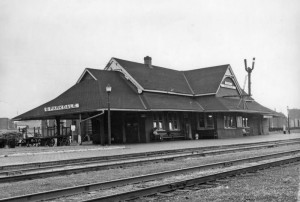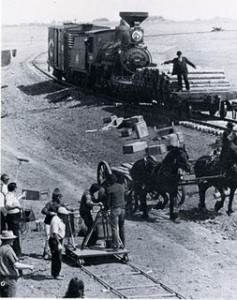Pierre Berton and the National Dream – Part 6 of 10
This is the sixth in a series of ten posts from an article prepared by Derek Boles, our TRHA historian on the occasion of the 35th Anniversary of the Groundbreaking TV “National Dream” Series – Russ Milland
Filming began in the spring of 1973. In typical Hollywood fashion, one of the last scenes in the production, the iconic driving of the Last Spike, was filmed first. Although this seminal event had occurred at Craigellachie, BC, the scene was filmed 2,300 miles to the east on CN’s disused Beeton Subdivision near the village of Caledon East, thirty miles northwest of Toronto.
Another scene shot in Toronto was the departure of Canadian troops to quell the Riel Rebellion. This was filmed at the 1878 Great Western/Grand Trunk/Canadian National Parkdale station, which had actually hosted the real event in 1885.
 In the picture at left, we see Toronto’s Parkdale station, built by the Northern Railway in 1878. It was used to film the departure of Canadian troops to quell the Riel Rebellion in 1885.
In the picture at left, we see Toronto’s Parkdale station, built by the Northern Railway in 1878. It was used to film the departure of Canadian troops to quell the Riel Rebellion in 1885.
Click on the picture for a closer look!
Locomotive No. 136 and its wooden cars were assembled in Calgary and “Work Extra 136” was dispatched to the western locations under its own power. The flat prairie required to show tracklaying progress across Saskatchewan in 1882 and 1883 was filmed along CP’s Cassils Subdivision in Alberta. The scenes of trains traveling through the Rocky Mountains were filmed on the Carmi Subdivision east of Okanagan Lake in the Penticton B.C. area. Both these lines saw little rail traffic at the time and CBC crews were able to film for days without interruption.

In the picture at left, we view the filming of construction scenes on the Prairies
Click on the picture for a closer look!
No. 136 and its train were then sent back to Calgary for exhibition at the annual Stampede. Meanwhile, the camera crew moved to the Coquihalla Gorge area of the CPR’s former Kettle Valley Line, east of Hope, B.C. The railway had abandoned this line several years previously and the track had been removed. The cleared right-of-way, unlined tunnels and partially dismantled trestles proved ideal for depicting railway construction through the mountains.
By Derek Boles, TRHA Historian
Click here to read Part 7.
Click here to return to Part 5.

